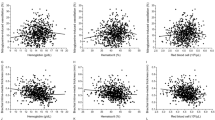Abstract
The purpose of this study was to determine if finger tip capillary blood hematocrit is a valid estimate of anticubital venous blood hematocrit at rest and after submaximal exercise. Simultaneous samples of finger tip capillary and venous blood were drawn from thirty-one subjects (15 males, 16 females) before and after a 15 min submaximal exercise on a bicycle ergometer. Venous and capillary blood hcts. were 42.0%±3.9 and 42.0%±3.5 respectively before exercise and 43.3%±3.5 and 42%±3.8 after exercise (¯X). The regression equation for predicting venous hct. from finger tip capillary blood after exercise was: Hct v = 0.87 Hct c+6.44 withr = 0.95 (P<0.05). The results indicate that the finger tip capillary microhematocrit method is a valid indicator of venous blood hct. following exercise.
Similar content being viewed by others
References
Cassels, D. R., Morse, M.: Blood volume and exercise. J. Pediat.20, 352 (1942)
DeLanne, R., Barnes, J. R., Brouha, L.: Hematological changes during muscular activity and recovery. J. appl. Physiol.15, 31–36 (1960)
Fahraeus, R.: The suspension stability of the blood. Physiol. Rev.9, 241–265 (1929)
Forester, H. V., Dempsey, J. A., Thompson, J., Vidvuk, E., DoPico, G. A.: Estimation of arterial PO2, PCO2, pH, and lactate from arterialized venous blood. J. appl. Physiol.32, 134–137 (1972)
Freis, E. D., Stanton, J. R., Emerson, C. P.: Estimation of relative velocities of plasma and red cells in the circulation of man. Amer. J. Physiol.157, 153–157 (1949)
Gibson, J. G., Peacock, W., Seligman, A., Sack, T.: Circulating red cell volume measured simultaneously by the radioactive iron and dye methods. J. clin. Invest.25, 838–847 (1946)
Konig, E., Widmann, W., Zöllner, N.: Veränderungen des Plasma-Volumens durch normale und maximale Arbeit im Sitzen. Z. ges. exp. Med.141, 350–366 (1966)
Larsen, O. A.: The hematocrit of the lower extremity in man at rest and during exercise. Scand. J. clin. Lab. Invest.21, 305–313 (1968)
McGovern, J. J., Jonse, A. R., Steinberg, A. G.: The hematocrit of capillary blood. New Engl. J. Med.8, 308–312 (1955)
Vehlinger, A., Buhlmann, A.: Das Verhalten des Blutvolumens während kurzfristiger körperlicher Arbeit. Bestimmungen mit Cr51- und I131-Albumin. Cardiologia38, 357–370 (1961)
Van Beaumont, W.: Evaluation of hemoconcentration from hematocrit measurements. J. appl. Physiol.31, 712–713 (1972)
Van Beaumont, W.: Red cell volume with changes in plasma osmolality during maximal exercise. J. appl. Physiol.35, 47–50 (1973)
Van Beaumont, W., Greenleaf, J. E., Juhos, L.: Disproportional changes in hematocrit, plasma volume, and proteins during exercise and bed rest. J. appl. Physiol.33, 55–61 (1972)
Author information
Authors and Affiliations
Rights and permissions
About this article
Cite this article
Fahey, T.D., Rolph, R. Venous and capillary blood hematocrit at rest and following submaximal exercise. Europ. J. Appl. Physiol. 34, 109–112 (1975). https://doi.org/10.1007/BF00999922
Received:
Issue Date:
DOI: https://doi.org/10.1007/BF00999922




